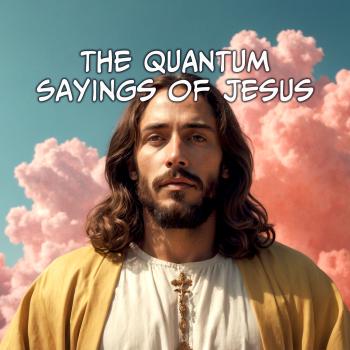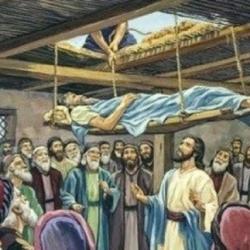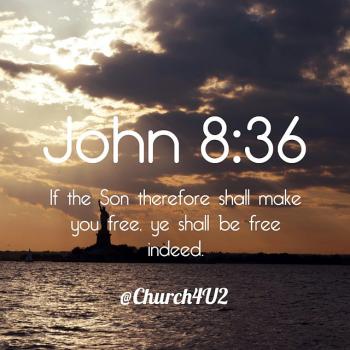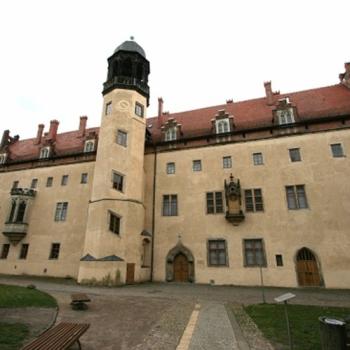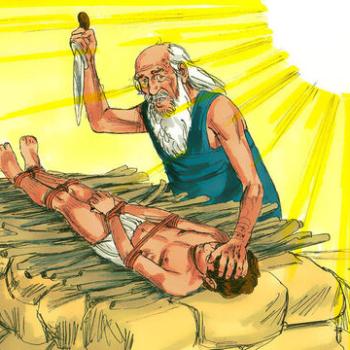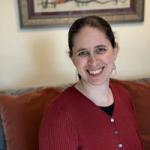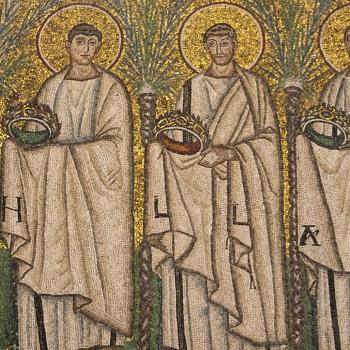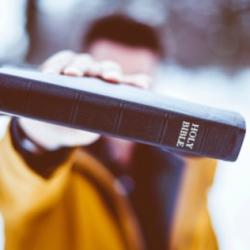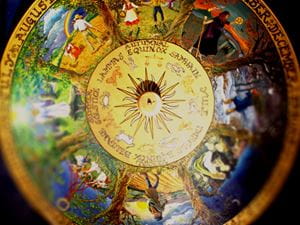
The Wheel of the Year is the cycle of holidays recognized by Wiccans and many other Pagans. For them, each year’s circuit retells the sacred narrative around the God and the Goddess, the masculine and feminine divine, and their relationship. For many, the God, sometimes referred to as the Horned God (Cernunnos or Kernunno), represents the Sun, and the Goddess represents the Earth. In other Pagan lore, the Goddess represents the Moon. The waxing and waning of the sun’s course through the year, and the subsequent light, growth, life, and warmth that come and go, provide the scaffolding for the Pagan festivals.
The Wheel includes the eight major festivals observed by most Pagans. Wiccans call these festivals the Sabbats. The eight festivals include four that are derived from ancient Celtic or western European traditions (sometimes called “the greater Sabbats”) and four from transitional times in the seasons of the year (sometimes called “the lesser Sabbats”). The four seasonal Sabbats include the two Equinoxes (Spring and Fall) and two solstices (Summer and Winter). Among other things, these festivals recognize the shift in time and light and, thus, are considered solar-based holidays. The two equinoxes are points of stability, of equality between darkness and light; the two solstices are times of transition, of shifts from light to growing darkness or darkness to growing light.
The cycle of holidays alternates between one festival dedicated to solar-based events or seasonal holidays, and one festival dedicated to earth-centered events, represented by those festivals that draw on ancient traditions. Each of these is an opportunity to worship gods and goddesses, welcome the changes of nature, draw on spiritual powers, and practice healing magic (or magick). Many Pagans gather during Sabbats to engage in these rituals communally
These major festivals are opportunities for Pagans to recognize the essential unity between the spiritual and the physical, between the earth with its seasonal transitions and the supernatural. Sabbat holidays are measured from sunset to sunset, and most of the rituals and magic are conducted at night. The Wheel of the Year begins on 1 November, so the first Sabbat of the year is the Winter Solstice, or Yule.
Yule, the Winter Solstice, usually falls on or around 21 December. As the shortest day and longest night of the year, the festival offers an occasion of reflection, of storytelling, of celebrating friendship, and welcoming the rebirth of the Horned God, as represented by the return of the light.
Imbolc usually falls in early February. It is a celebration of the waning winter and the early signs of spring. Because of the lingering darkness, the festival is associated with bonfires, and, in recognition of the hints of spring, it is associated with fertility and new life. Some Pagans refer to it as Brigid’s Day. Brigid was a renowned Celtic goddess in pre-Christian lore. The Roman Catholic saint—St. Brigid of Kildare (circa AD 451-525)—is believed to be a syncretizing of the Pagan goddess with a sainted Irish nun; the two sharing the same feast day (February 1), gifts for healing, and stewardship for protecting domestic animals.
Ostara, the Spring Equinox, usually falls in March. As Pagans welcome the onset of spring and the end of winter, their celebrations include many of symbols of new life, like eggs, flowers, and plantings.
Beltane, which usually falls on the first of May, has Celtic origins, and the name means “the fires of Bel.” Bel was another Celtic deity, one associated with the onset of summer, sexual maturity, fertility, and a celebration of life. Maypoles and dances, bonfires, and a variety of courtship rituals express a welcoming of summer. This is the festival that, for many Pagans, marks the mating of the Horned God and the Goddess (of the moon or Mother goddess), creating the possibilities of new life.
Midsummer, the Summer Solstice, is the height of the sun’s power. As the longest day of the year, and the shortest night, Midsummer represents for many Pagans the full maturity of the Horned God (the masculine divine essence) and the height of the Goddess’s power.
After the Summer Solstice, or Midsummer, Pagans gather again (this time in early August) for Lughnasadh—sometimes referred to as Lammas. The god Lugh was a great warrior, and his victories are symbolic for the earth’s victories through the summer. Thus, Lughnasadh is an important festival—the first of three harvest festivals—focused on thanksgiving, welcoming the early harvest, and honoring the gifts of the summer that is passing.
The Fall Equinox, or Mabon, presents the fullness of autumn and harvest, and is also a celebration of thanksgiving; a time to express rich appreciation for and share the bounteous gifts of the summer. In these expressions of gratitude and sharing, it is believed that one may secure the blessings of the god and goddess during the potentially harsh winter months. Pagans use the time to reflect on the temporariness of all things and accept the transitions that life brings.
Samhain, also known as All Hallows’ Eve, falls on 31 October. This is, perhaps, the most well-known of Pagan holidays in non-Pagan circles because it falls on the culturally popular holiday, Halloween. As the last festival of the Wheel of the Year and one that, in the Northern Hemisphere, takes place in increasing darkness, it becomes the opportunity to recognize the cycle of life, embrace the reality of death, and respect ancestors. For some, it is believed that the spirits of the deceased—whether family members, close friends, or even pets—by actually attend rituals performed on this Sabbat, if invited.
Read more about Pagan rituals and practices here.
3/14/2023 4:39:18 PM
